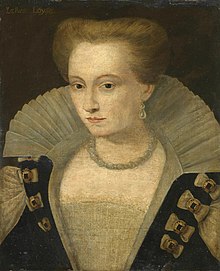Louise de Lorraine-Vaudémont
Louise de Lorraine-Vaudémont (born April 30, 1553 in Nomeny , † January 29, 1601 in Moulins ), also known as Louise de Mercœur , was the wife of Henry III. Queen of France from 1575 to 1589.
Life
Childhood and youth
Louise was born as the daughter of Nicolas' de Mercœur , Count of Vaudémont and Duke of Mercœur , at Nomeny Castle in Lorraine . She was the oldest of a total of 14 children who resulted from her father's three marriages. When her mother Marguerite d'Egmont died, she was only one year old. Her childhood was not very happy, she was hated by her father and stepmother Catherine von Lorraine-Aumale and mostly kept away from the family. So as an adult she became a very quiet, dutiful and deeply religious woman.
marriage
In 1574 she met her future husband Heinrich, the then Duke of Anjou . This visited her uncle Karl III. of Lorraine , who was married to Heinrich's sister Claude . Heinrich was just passing through to Cracow , his new residence as King of Poland . He was very taken with Louise because she was not only blonde, beautiful and graceful, but also very much like Maria von Kleve, Heinrich's great love, who was already married to Henri I de Bourbon .
After the death of his brother Charles IX. Henry turned his back on Poland and went back to France to succeed him as King Henry III. to compete. Louise was not yet traded as the king's wife, because Heinrich initially wanted Maria von Kleve to divorce her husband and then marry him. But Maria died unexpectedly of pneumonia, so Henry III decided. against the advice of his courtiers and especially his politically very active mother Catherine de Medici to marry Louise. He sent his confidante Philippe Hurault de Cheverny and Michel du Guast to convey his request to the young woman and her family.
The wedding took place on February 15, 1575 in Reims Cathedral , just two days after Henry's coronation.
Queen of France
Louise suffered greatly from the hostility of her family, the House of Lorraine, towards her husband caused by the Huguenot Wars .
Although she admired Heinrich very much and he was equally impressed by her despite repeated infidelity, their marriage remained childless. It is believed that the queen miscarried in 1575 and was henceforth unable to bear children. Other sources claim that Heinrich was unable to procreate. Heinrich's brother-in-law Heinrich von Navarra was already regarded as heir to the throne. The Queen suffered greatly from this burden, became very emaciated, began to suffer from depression, and made numerous pilgrimages with her husband to pray for offspring.
In 1589, Louise inherited Chenonceau Castle from her mother-in-law, who died on January 5, and stayed there when her husband was assassinated on August 2, 1589. She fell into an even deeper depression, spent the rest of her life in mourning clothes and hung the castle with gloomy tapestries . She covered her face with a white veil and has since been called La Reine Blanche (German: the white queen ).
Louise died in Moulins and was buried in the Capuchin monastery in Paris . It was not until 1817 that her remains were transferred to the Saint-Denis basilica at her husband's side .
literature
- Jacqueline Boucher: Deux épouses et reines à la fin du XVIe siècle: Louise de Lorraine et Marguerite de France . University of Saint-Etienne, 1995, ISBN 2-86272-080-1 .
- Chantal Clémen: Louise de Lorraine-Vaudémont, pure de France . Ed. la Plume du temps, Guilherand-Granges 2002, ISBN 2-913788-39-4 .
- Hilarion de Coste: Louyse de Lorraine, reyne de France et de Pologne ( Memento of April 5, 2008 in the Internet Archive ) . In: Les Eloges et les vies des reynes, des princesses, et des dames illustres en pieté, en Courage & en Doctrine, qui ont fleury de nostre temps, & du temps de nos Peres . Vol. 2, 2nd ed. Sébastien et Gabriel Cramoisy, Paris 1647, pp. 107–157.
- Ghislain Tranié: Louise de Lorraine (1553-1601). L'esprit & la lettre d'une Reine de France ( Memento of November 24, 2004 in the Internet Archive ) . Université Paris IV Sorbonne, Paris 2002.
Web links
- Short biography ( memento of February 16, 2008 in the Internet Archive ) (French)
- Essay on Louise de Lorraine-Vaudémont by Jacqueline Boucher ( Memento from April 5, 2008 in the Internet Archive ) (English, French)
| predecessor | Office | Successor |
|---|---|---|
| Elisabeth of Austria |
Queen of France 1575–1589 |
Margaret of Valois |
| personal data | |
|---|---|
| SURNAME | Lorraine-Vaudémont, Louise de |
| ALTERNATIVE NAMES | Louise de Mercœur, La Reine Blanche |
| BRIEF DESCRIPTION | Queen of France (1575–1589) |
| DATE OF BIRTH | April 30, 1553 |
| PLACE OF BIRTH | Noun |
| DATE OF DEATH | January 29, 1601 |
| Place of death | Moulins |

